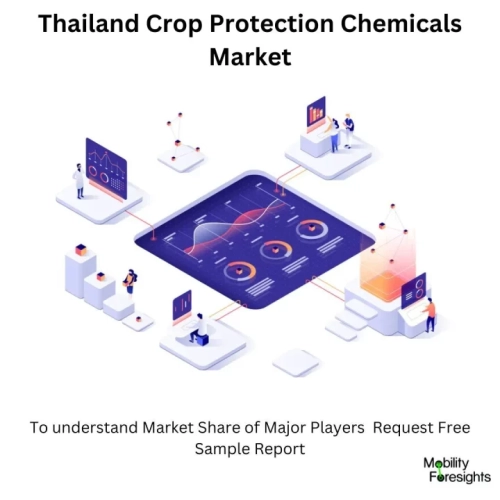
- Get in Touch with Us

Last Updated: Apr 25, 2025 | Study Period:
The Thailand Crop Protection Chemicals Market is poised for steady growth, driven by the country's reliance on agriculture, which contributes approximately 10% to its GDP. The market's expansion is being propelled by increased agricultural productivity, technological advancements in farming, and government incentives that encourage the use of innovative crop protection products. The demand for both synthetic and bio-based chemicals is strong, with herbicides leading the market, particularly due to the extensive cultivation of rice, sugarcane, and maize.
Technological innovation is transforming the market, particularly through the adoption of precision farming techniques, drone technology, and data analytics, which help farmers optimize the use of crop protection chemicals. However, the market faces challenges, including rising raw material costs and the development of resistance among pests to existing chemicals. Moreover, stringent environmental regulations are pushing manufacturers to innovate toward safer, more sustainable solutions. The integration of organic pesticides is also gaining momentum as farmers respond to consumer demand for greener agricultural practices.
The Thailand Crop Protection Chemicals Market refers to the range of chemicals used to protect crops from pests, diseases, and weeds. This market plays a critical role in ensuring the productivity and sustainability of Thailand's agriculture sector, which is a key contributor to the country's economy. The market includes a variety of products designed to enhance crop yield and protect against potential losses.
Crop protection chemicals can be divided into several categories, including herbicides, insecticides, fungicides, and bio-based alternatives. Herbicides hold the largest share, followed by insecticides, which are essential for protecting Thailandâs high-value crops like fruits and vegetables. Bio-based chemicals are gaining prominence due to their environmental benefits and lower toxicity.

These chemicals are primarily used in Thailandâs vast rice paddies, sugarcane fields, and horticultural areas, providing protection against pests and diseases that threaten crop yield. With increasing export demand for Thai agricultural products, the use of high-quality crop protection chemicals has become even more critical to meet international standards.
While crop protection chemicals significantly enhance productivity, their use comes with challenges such as environmental concerns, regulatory pressures, and the development of resistance among pests. The market is now seeing a shift toward sustainable farming practices, with integrated pest management (IPM) and bio-pesticides becoming more prevalent.
As of 2023, the Thailand Crop Protection Chemicals Market is valued at approximately USD 580 million and is projected to reach USD 880 million by 2030, registering a CAGR of 6.4%. The growth is driven by increased agricultural output, technological advancements in crop protection, and a shift toward sustainable farming practices. Key drivers include the rise in demand for bio-based chemicals and the expansion of precision farming techniques, which optimize chemical use.
Technological advancements such as precision agriculture, drone-based pesticide spraying, and AI-driven crop monitoring are reshaping the market. These innovations help farmers use chemicals more efficiently, reducing costs and environmental impact. Consumer demand for organic produce is also influencing the market, with bio-based chemicals becoming more popular. Additionally, government policies favoring sustainable agriculture and the phasing out of harmful chemicals are shaping the future landscape.
By Product Type:
By Crop Type:
By Technology:
By Distribution Channel:
| SI No. | Topic |
| 1 | Market Segmentation |
| 2 | Scope of the Report |
| 3 | Research Methodology |
| 4 | Executive Summary |
| 5 | Key Predictions of the Thailand Crop Protection Chemicals Market |
| 6 | Market Size, Dynamics, and Forecast, by Geography (2024-2030) |
| 7 | Market Size, Dynamics, and Forecast, by Product Type (2024-2030) |
| 8 | Major Drivers for the Thailand Crop Protection Chemicals Market |
| 9 | Technological Developments in Crop Protection Chemicals |
| 10 | New Product Development in Thailand Crop Protection Chemicals Market |
| 11 | Key Trends in the Thailand Crop Protection Chemicals Market |
| 12 | Competitive Landscape of the Thailand Crop Protection Chemicals Market |
| 13 | Top Players and Company Profiles |
| 14 | Government Agricultural Initiatives |
| 15 | Import and Export of Crop Protection Chemicals |
| 16 | Impact of Environmental Regulations on the Market |
| 17 | Major Projects Utilizing Crop Protection Chemicals |
| 18 | Pricing Trends by Region |
| 19 | Research Focus Areas for New Products |
| 20 | Key Consumer Segments |
| 21 | Future Outlook and Forecast (2030) |
| 22 | Unmet Needs and Opportunities |
| 23 | Conclusion |